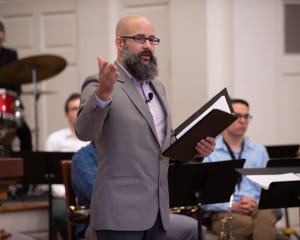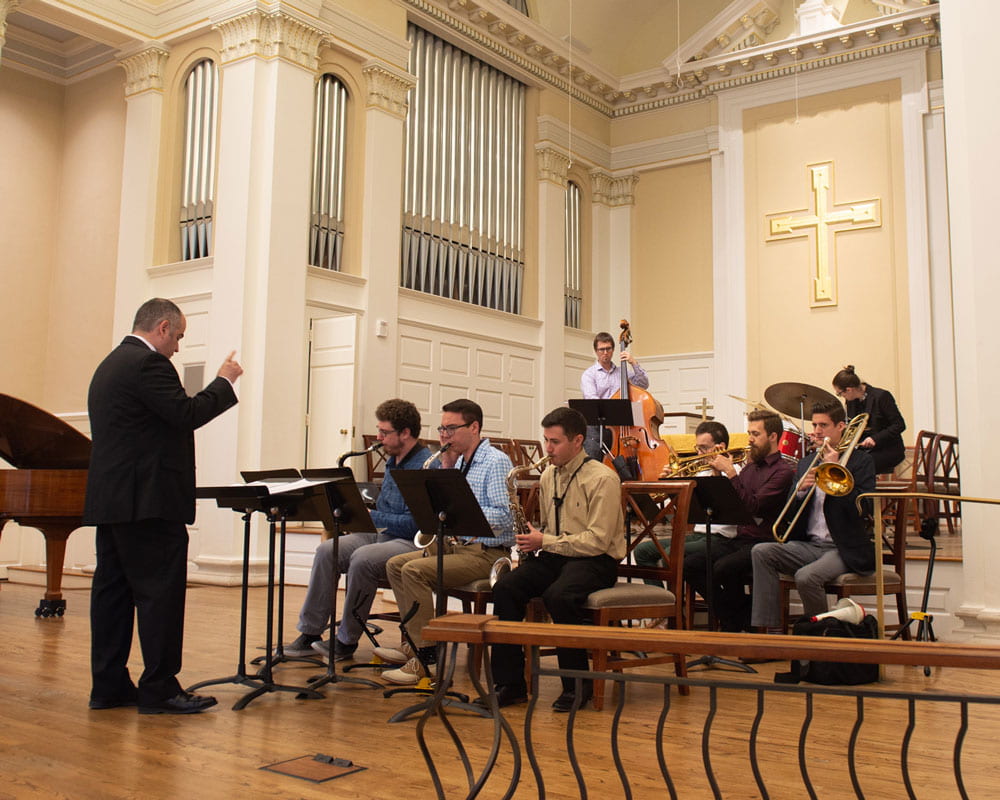As sacred spaces go, Perkins Chapel has always been rather austere and stately. But on May 20, 1959, it showed it could swing.
That day Perkins Chapel hosted the first-ever jazz liturgical service.
Ed Summerlin, an accomplished saxophonist doing graduate studies at North Texas State College, wrote the music. He led a nine-piece jazz band from that school, and together, with the help of Perkins faculty who read Scripture and preached, they crossed a cultural boundary.

The boldness and novelty of the event, and the poignant circumstances that inspired it (more about that later), attracted national news coverage. “Jazz goes to church” was one headline for an Associated Press story that ran in newspapers across Texas and beyond.
Over the decades, and perhaps inevitably, memories of the historic service faded. That was true even at Perkins.
But a passionate jazz expert from afar, Derick Cordoba of the University of Illinois at Urbana-Champaign, knew all about the service. Cordoba had done his 2017 doctoral dissertation on Summerlin and the origins of jazz liturgy.
Feeling the service’s 60th anniversary should be observed, he reached out to Perkins last fall with the idea of reprising it in the original venue.
“It was quite a nice surprise to hear from Dr. Cordoba,” said Mark Stamm, professor of Christian Worship and Chapel Elder. “He said, ‘Would you like to do this?’ I said, `Yeah.’”
Cordoba coordinated with Stamm and, especially, Marcell Silva Steuernagel of Perkins’ Master of Sacred Music Program.
On April 24, Perkins Chapel again was enlivened by a nine-piece jazz combo from the University of North Texas (as the school is now known), this time directed by Cordoba, and playing for a jazz liturgy service that closely followed the original.

Steuernagel offered a stirring homily (drawing on Jesus’ singing of a hymn with the disciples at the Last Supper), and he and Perkins’ Margot Perez-Greene led the readings. The artwork for the program, done by Margaret Rigg, had originally appeared in the fall 1959 issue of Perkins Journal.
Cordoba praised the young musicians afterward and said how personally meaningfully it had been for him to lead them in playing Summerlin’s music, and in the very place where jazz liturgy debuted.
“Ed Summerlin passed away in 2006, so I never got to meet him,” Cordoba said. “I feel like I have a point of connection now.”
In a lecture at Perkins after the service, Cordoba shared how the first service came to be.
Summerlin was, in 1959, an experienced professional jazz player, composer and arranger, pursuing a doctoral degree in music at North Texas State. But he and his wife, Mary Elizabeth Summerlin, were also grieving the death of their infant daughter, Mary Jo, from a heart defect.
The Rev. Bill Slack Jr., assistant pastor of First Methodist Church in Denton, had counseled the couple through the tragedy. A few weeks afterward, Slack suggested Summerlin consider writing music for a church setting.
Summerlin agreed to think about it, and soon got busy writing jazz intended for a worship service but also as a memorial to his daughter.
Various steps ensued, but the result was the May 20, 1959, service at Perkins Chapel.
Perkins faculty member Roger Ortmayer, who taught Christianity and the arts, had commissioned Summerlin’s effort and worked with him on integrating the music with the liturgy. Schubert Ogden and J. Paul Sampley served as ministers, with Sampley giving the sermon. A choir (which the 2019 service did not have) joined the jazz band in providing the special music.
The service drew on The Wesley Orders of Common Prayer – which Stamm explains was essentially the 1662 Book of Common Prayer – and included the hymns “Love Divine, All Loves Excelling” and “God of Grace and God of Glory.”
Crucial to the service were Summerlin’s own instrumental compositions, including one that Slack would later describe as his friend’s attempt to evoke Mary Jo’s brief life.
Ogden, for one, felt that this experiment in drawing on jazz for worship had great significance. On the day of the service, the famed Perkins professor wrote Summerlin: “I am delighted to think that the tragic separation between the church and the life of our time – which is the bane of both our existences – may have been dealt a heavy blow by this joint effort.”
The considerable press coverage included a lengthy televised segment titled “A Requiem for Mary Jo.” It aired on NBC’s “World Wide ‘60” program, hosted by Chet Huntley. Summerlin led other performances of the service in a range of settings, and did a recording, “Liturgical Jazz,” that earned a rave review in DownBeat magazine.
He would have a long career that included founding the jazz program at City College of New York and writing other liturgical jazz works. He also composed and arranged for – and performed with – some of the biggest names in jazz.
But Summerlin remains a rather obscure figure, not nearly as identified with sacred jazz as Duke Ellington, John Coltrane and Mary Lou Williams, all of whom wrote major works on religious themes.
Cordoba had never heard of Summerlin and the Perkins service until he read the great jazz bassist Ron Carter’s account in a book. For Cordoba, himself an accomplished guitarist, that sounded like a dissertation subject. And eventually it became his.
One main task was to determine that Summerlin really did make history at Perkins Chapel on May 20, 1959.
“This is the first complete service of worship that was jazz,” Cordoba said. “I spent a lot of time, actually, researching to make sure I could make that claim.”
Among the musicians who worked with Cordoba in recreating the service was Colleen Clark, a drummer who recently defended her own dissertation at The University of North Texas. She teaches jazz history, and the chance to honor Summerlin’s contribution thrilled her.
“What a historical moment, to be able to celebrate this in the place where it originally happened,” she said. “I’m so proud we could all do this together.”
